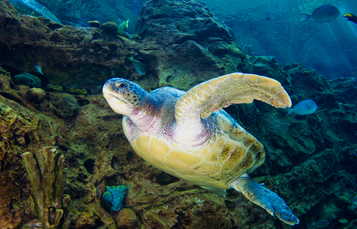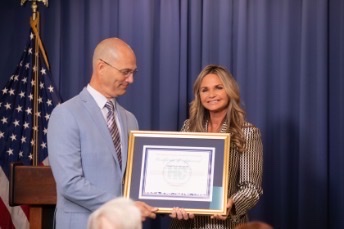SeaWorld's Commitment to the Care and Conservation of Dolphins Around the World
May 12, 2023At SeaWorld, our many teams – from rescue and research to veterinary and animal care – provide exceptional and accredited care to our dolphins every single day.
Rooted deep in the history of our organization, dating back to our origins in the 1960’s, is a legacy of providing expert care to the animals in our parks and an inherent curiosity for and drive to protect their wild counterparts. For years, SeaWorld has been lauded as one of the leading marine mammal rescue organizations in the world. With trusted rescue teams on both the east and west coasts as well as the Texas gulf, we are often called to assist with rescue and rehabilitation efforts in some of the most critical scenarios.
One recent example is Ridgway, the dolphin calf who was deemed non-releasable by NOAA after being rescued last July in Clearwater Beach where he was found entangled in the remnants of a crab trap line. Ridgway had life-threatening injuries and wasn’t able to swim on his own, so he was brought to SeaWorld Orlando for rehabilitation. Though breathing on his own upon arrival, he was unresponsive and in a coma, so the team moved him into intensive care. Less than 30 minutes later, our on-site laboratory and veterinary team diagnosed the cause of his catatonic state, isolating his critical condition to a life-threatening electrolyte imbalance, pneumonia, and serious injuries to his fins from prolonged lack of blood flow due to the restrictive lines he was entangled in. Our team worked around the clock, providing hour-by-hour critical medical care, adjusting water salinity and even walking with him in the pool supporting his weight until he regained the strength to swim on his own.
Since, Ridgway has made leaps and bounds in the way of progress. He learned how to take a bottle, which has helped him grow to a healthy weight. He also progressed in his physical therapy, underwent multiple procedures to remove necrotic tissue resulting from his injuries, and has now integrated successfully into the Dolphin Nursery where he is learning how to be a dolphin from experienced mothers and other juveniles.
SeaWorld is a trusted partner of the Southeast Stranding Network and works closely with National Marine Fisheries Service and other partners to assist whenever called.
In addition to this important rescue work, SeaWorld has been at the forefront of marine animal research since the 1963 establishment of the Hubbs-SeaWorld Research Institute. Scientists both inside and outside of our organization have worked with the animals in our care to better understand their behaviors, anatomy, and biology – something that is sometimes difficult to study in the wild. Our researchers have also applied their knowledge toward the study of wild dolphin populations, publishing numerous peer-reviewed research studies on new findings in dolphin health and behavior. Some topics include the first-ever hormone categorization techniques that led to groundbreaking understandings in dolphin reproduction, and the recent development of a new method of estimating dolphin age using DNA Epigenetic Aging Clocks (accurate age estimation is a critical component of health assessments in wild dolphins and ensures a better understanding of age-specific nutritional and health requirements).
We also lend support and funding to dolphin research and conservation projects around the world through the SeaWorld Conservation Fund. Just this year, the Fund announced 22 grants were distributed, some of which went directly to organizations working on rescue, research, and conservation efforts around various types of dolphins. One grant provided to the Texas Marine Mammal Stranding Network will be used to increase the Network’s capacity for marine mammal rescue and rehabilitation in the state of Texas. This is particularly important in protecting the dolphin population in the Gulf of Mexico. Another grant went to AMPA-Friends of Manatee Association for monitoring an Amazon river dolphin population to assess their behavioral and reproductive patterns.
The SeaWorld Conservation Fund has a long history of aiding dolphin conservation, even outside of the US. In fact, this year’s grant to AMPA-Friends of Manatee Association is not the only Amazon river dolphin conservation effort to receive funding support in our history. The Amazon River Dolphin Conservation Foundation (ARDCF) has long been a recipient of funding to help protect and conserve the species in Brazil. Since 2014, the ARDCF has been working with riverside indigenous communities to survey and identify the dolphins in the Amazon basin. Grants provided by the SeaWorld Conservation Fund allowed the Foundation to purchase equipment like cameras, canoes, and boats that are critical to navigating the waterways and cataloging their work.
The work does not stop there. Every day, our veterinarians, animal care specialists, and trainers provide expert care to each and every dolphin in our parks. From bottle feedings and meal prep to routine health exams, playtime and exercise, our teams have dedicated their lives to ensuring these animals have everything they need to thrive. This work would not be possible without one critical thing: a strong bond and level of trust from the dolphins. As we continue to learn from those in our care, we can continue to make positive impacts on the environment for future generations of dolphins in the wild.





